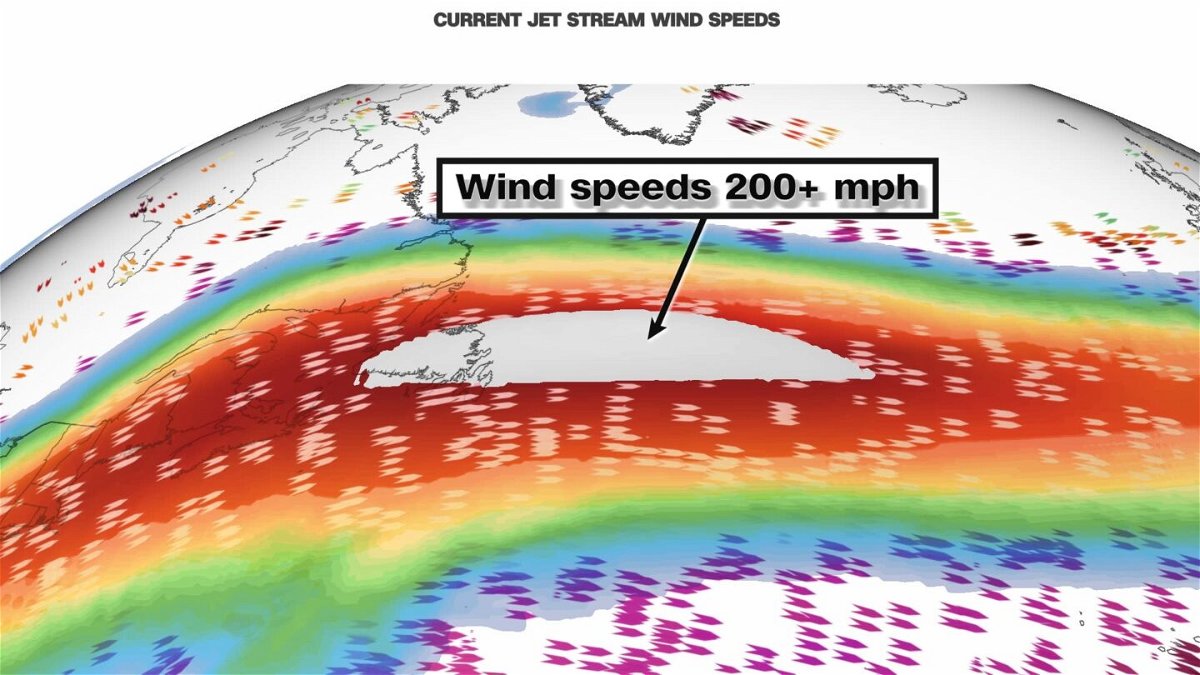Transatlantic airplanes are flying at the ‘speed of sound’ right now. Here’s why

Julia Buckley, CNN
(CNN) — Savior of many a cramped pair of legs, the jet stream is well known for lopping roughly an hour off long haul west-to-east flights.
But it’s working especially hard for travelers in economy class right now, with the jet stream over the Atlantic so strong that flights heading from the US to Europe are reaching speeds equivalent to that of sound.
Sound travels at about 761 mph or 1,100 feet per second in “sea level standard conditions,” according to NASA – a little over 661 knots.
In the past 24 hours, passenger aircraft traveling east from the US across the Atlantic have reached up to 778 mph. That’s a little over 200 miles per hour faster than normal cruising speeds.
But if you’re thinking these flight times are a match for the much-missed Concorde, whose sonic booms used to mark it breaking the sound barrier, it’s time to think again. There’s a difference between ground speed and speed in the air (indicated air speed, essentially the speed of the plane in relation to the air around it). These passenger flights, however speedy, didn’t break the sound barrier.
But they did slash flight times. Emirates flight 222 from Dallas to Dubai arrived 57 minutes early on November 1, having reached a top speed of 675 knots, or 777 mph, off the coast of Newfoundland, according to flight tracking site Flightaware.
American Airlines flight 106 from JFK to Heathrow arrived 54 minutes early on Wednesday morning, with a flight time of just six hours and seven minutes. It reached a top speed of 778 mph, or 676 knots, also just past Newfoundland.
Meanwhile Delta flight 186 raced from Los Angeles to London with top speeds of 760mph, arriving half an hour early on November 1 at 1.08 p.m.
A KLM cargo plane which took off nearly four hours late on November 1 was due to arrive just under two hours late, traveling from Miami to Amsterdam.
The jet stream explained
The jet stream is a “core of strong winds around five to seven miles above the Earth’s surface, blowing from west to east,” as the UK’s Met Office describes it.
It’s the reason why eastbound flights tend to be shorter than westbound ones – with long haul flights racking up time differences of an hour or more, depending on the direction of travel.
Seven miles above the planet’s surface is equivalent to around 37,000 feet – which means that aircraft at cruising altitude slip easily into the jet stream.
And it’s the rapidly cooling weather stateside this week (now heading to Europe in the form of Storm Ciaran) that’s responsible for the speeding up of the winds, according to CNN meteorologist Sara Tonks.
“This week’s burst of cold air in the United States has upped the difference in temperature between the United States (cold!) and the Atlantic Ocean (warm!),” she says.
“This increase in the temperature gradient is amplifying the speed of the jet stream, which is driven by temperature differences.
“The jet stream is expected to help strengthen Storm Ciaran, a low pressure system and potential bomb cyclone that is expected to arrive in Europe tonight [Wednesday].”
CNN meteorologist Derek Van Dam added: “Remember, ground speed is how fast an airplane is traveling, relative to a fixed point on the ground versus airspeed which is the speed of an aircraft relative to the air through which it is moving. Either way, these planes are saving time and money.”
However fast the flights this week, they have a little way to make up for some record-breaking flights pre-pandemic.
In February 2019, a Virgin Atlantic plane flew at 801mph from Los Angeles to London, reaching its top speed over Pennsylvania thanks to a 200mph jet stream – although it slowed down to a mere 710mph once it hit the ocean. The aircraft – a Boeing 787 Dreamliner – usually has a cruising speed of around 560mph. Virgin founder Richard Branson described it as flying “faster than any other commercial non-supersonic plane in history.”
its record was broken the following year by a British Airways Boeing 747. The BA jumbo clocked in at 825mph on a New York to London flight, slashing the journey time from around seven hours to just under five. On that same day, another Virgin Atlantic plane made the same route with a journey time of just two minutes more.
The-CNN-Wire
™ & © 2023 Cable News Network, Inc., a Warner Bros. Discovery Company. All rights reserved.